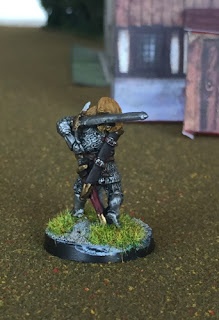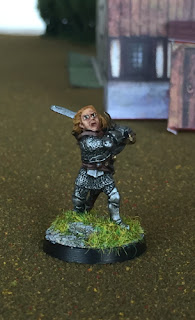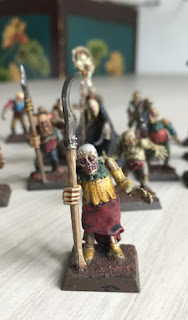I grew up in Milan as a city boy, living in a flat. I was lucky enough, being a single child, to have my own room, but I never had a large gaming space or table, like people with a house do. As a result, even if I had miniatures to play as a teenager, I wouldn’t have had the space to play games with them.
This all changed when I was 39, on 8th November 2018. Last summer I closed part the roof turning it into a veranda, and the other day I received the table, which I promptly set up as a gaming table for my first ever real game of Warhammer Fantasy Battle.
Let me stress this:
MY. FIRST. GAME. OF. WARHAMMER. FANTASY. BATTLE.
Here I need to explain two things: first, I’ve been an Oldhammerer since 1995, but I always played WFRP, not the Fantasy Battle. Second, in 1996-ish, I actually bought two units of High Elves from a friend, and we spend an afternoon setting up a game of WFB, but being young, inexperienced in wargames and not really strong in interpreting photocopied English-language battle manuals, we never really got beyond the shooting phase of the first turn, so that doesn’t count.
But now I am playing, even if solo, and I feel like a happy teenager, overly excited about his toy soldiers and cardboard buildings, jumping up and down as he sets up the table.
This of course deserves a battle report, for obviously historical records. The battle was between two small forces of High Elves (
those High Elves, yes, waiting for actions for 23 years) and Undead, with the fluff going more or less like this: Thelenor the Vengeful, Knight of Caledor, was at the command of a small force of High Elves aboard the ship Sunsail, which was docked near the coast of Bretonnia, north of Mousillon, to monitor piracy and smuggling, when he received a plea from the villagers on the coast. A Necromancer, Jacques Prévert, was half a day away with an army of undead and heading for the village, with the aim of increasing his forces. Thelenor, bored with the long inactivity and longing to ride on dry land, immediately mobilized his forces. He ordered the evacuation of the village of Sablont and as the inhabitants boarded their boats, Thelenor’s forces took defensive position around the village and especially its graveyard, where the Necromancer would probably be heading.
Thelenor’s forces were so composed (for a total of 845 points):
- Thelenor the Vengeful, lvl 15 High Elf Hero, Mounted on Warhorse, armed with a Blade of Piercing
- 4 Caledor Knights (Heavy Knights) mounted on Warhorses
- 10 Elven Spearmen
- 10 Elven Archers
- Tordael, lvl 10 Elf Archmage
As dusk neared, the forces of the Necromancer appeared (for a total of 692 points):
- Jacques Prévert, lvl 25 Necromancer, equipped with Staff of Intelligence, Will and Impunity
- 20 Zombies
- Théophile Gautier, lvl 15 Undead Hero
- 9 Skeleton Warriors
The Undead approached the village divided in three units: Théophile with his Skeletons from the South, trying to draw Thelenor’s Knights out of the village. On his right 10 zombies were ready to support him. Prévert marched with other 10 Zombies from the East, heading directly towards the graveyard, only protected on that side by the Elf Archers under the command of Tordael.
Turn 1
Théophile manoeuvred to draw the knights out of their defensive positions, while Prévert marched at full speed towards the graveyard, opening hostilities with a volley of fireballs that engulfed three archers. Thelenor took the bait and ordered an immediate charge on the Skeletons, hoping to vanquish them easily but only destroying three and wounding lightly their leader. Behind him, the Elven Spearmen followed up to protect his rear. The archers turned to face the Zombies and fired at them, but only felled one: Todael bravely fired his only Fireball at the enemy, burning three more Zombies.
At this point it was already midnight and, to my surprise, I heard a bird singing on top of the veranda - what could it be? A quick search on the internet through bird songs informed me it was probably a robin, possibly confused by the unusual light. Sorry little friend! I’ll try not to disturb you too much in the future!
Turn 2
The knights of Caledor, to their horror, found themselves bogged down in the fight with the Skeletons, fighting until the very last of them was destroyed. On their rear, the Elf Spearmen met with the charge of the Zombies, resisting valiantly but only putting down 3 of them. Meanwhile the Necromancer was reaching the graveyard and casting a Fetid Cloud on it: Tordael, having lost another Elf, showed great leadership in executing a complex manoeuvre to march backwards, out of reach for the enemy and the Fetid Cloud, while shooting and casting (Destroy Undead) at the Zombies. These were badly hit and, by the end of the turn, Prévert stood alone in the graveyard.
 |
| Even a 1'' Fetid Cloud can be quite deadly |
 |
| Prevert stands alone in the graveyard, all his creatures destroyed |
It was quite late now, and I decided to go to bed and continue the following day…
Turn 3
Prévert was now standing alone in the centre of the graveyard: in spite of being faced with so many enemies, he smiled a mad smile, while he chanted a spell... and all his fallen zombies began to rise, and the tombs opened to let out old skeletons. In but a few moments, he was surrounded by new undead warriors (he cast Raise Dead, getting 21 between Zombies and Skeletons).
Unnerved by this development, the elven archers retreated some steps back in order to avoid the Fetid Cloud moving in their direction; they shot their arrows and Tordael cast again his curses (Destroy Undead) felling 6 Zombies on the spot. Meanwhile Thelenor and his knights, having vanquished the Skeletons to the south, turned their steeds and came to help the spearmen. Their charge hit the Zombies hard, but still they carried on fighting, unable to feel fear.
Turn 4
Prévert separated Skeletons from Zombies and ordered the latter to charge Tordael and his archers, confident that they would not resist, but he underestimated his own Fetid Cloud: out of six Zombies who entered it, only two survived. One was impaled by the dagger of Tordael, while another was pushed back into the Cloud and killed by it.
But the Necromancer was not overly concerned with the archers, and made to turn against the other Elves. As the last Zombies were butchered by Elf Knights and Spearmen, the Skeletons left the graveyard and advanced through the swampy terrain next to it. The Elves accepted the challenge and, after killing the last Zombie, they prepared to charge.
It was at this point that Prévert cast a volley of fireballs against the knights, killing two of them on the spot and sending the others into an inglorious flight, along with their leader who could not restrain his horse. The Elf Spearmen, showing great discipline, charged the Skeletons, pushing them back towards the graveyard.
 |
| The outcome of the volley of fireballs... |
 |
| The spearmen charge through the swamp |
Turn 5
Prévert was now exhausted: he had no more strength to cast any spell and had to rely only on his Skeletons, pushed back by the Spearmen and targeted by the Archers. In his panic, he forgot to make use of the Fetid Cloud, which could have helped him against his foes, and he simply tried to break fight and flee the battlefield, but he could not control his own forces and was delayed, as the Elven Spearmen destroyed his Skeletons and gravely wounded him.
On the other side of the battlefield, Thelenor at last managed to ease his steed and turn it to face his foe. He rode like the wind, alone and last of the Knights of Caledor, to meet his enemy.
 |
| "I should probably go back... " |
Turn 6
The Necromancer finally managed to retreat from the fight, marching backwards towards the edge of the table. He attempted to move the Fetid Cloud and use it as a barrier, but his power was now too weak (having rolled 1 on a d6, he moved the cloud only 1''). The Spearmen charged him once again, joined by Thelenor, and Prévert at last met his end from the tip of an elven spear. Thus the battle of Sablont ended.
The Aftermath
Thelenor returned to the Sunsail with a heavy heart. Although he was hailed as a saviour by the villagers, many valiant Elves had fallen against the Undead, and he had marred his reputation by fleeing the spells of the Necromancer. At least Prevert was now dead, and his accursed staff was held on the elven ship. Tordael would study it, hoping to increase his basic skills of Necromancy that had allowed him to keep at bay a much stronger Wizard. He was the true hero of Sablont battle, having defended the graveyard and delayed the Necromancer until the arrival of reinforcements. The villagers were grateful to the Elves and would remember the event for generations, telling the legends of the Death of the Necromancer.
The battle was immense fun. WFB 3rd edition is a bit slow but in my opinion strikes a nice balance between fun and realism. The best part was seeing how the battle evolved into an epic story. Can't wait to play again, possibly against a human adversary!










































































